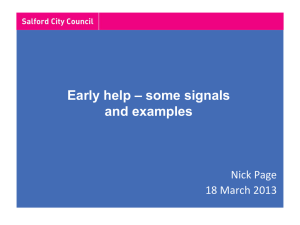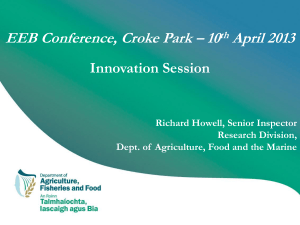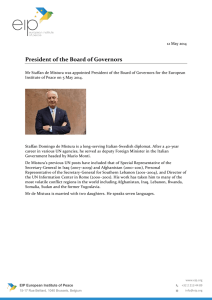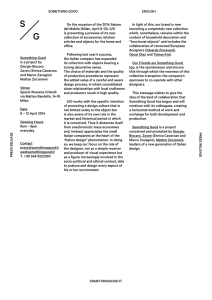Matteo Caroli, Luiss University, Rome
advertisement
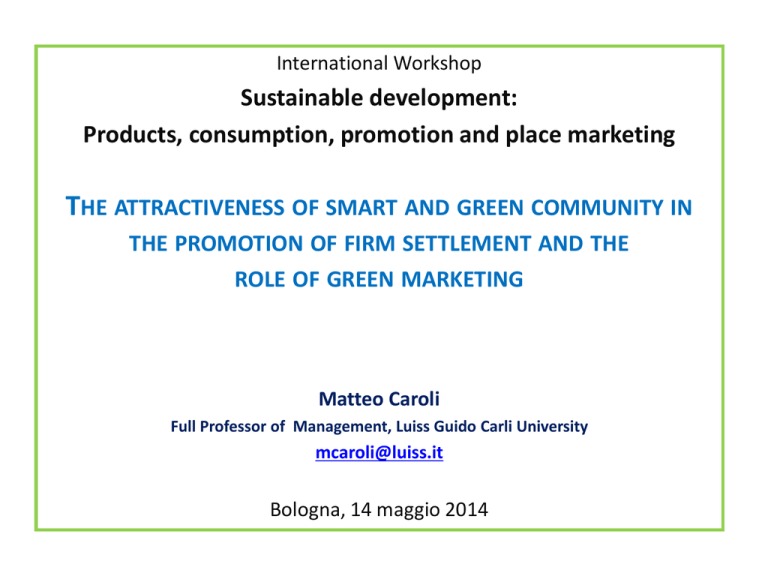
International Workshop Sustainable development: Products, consumption, promotion and place marketing THE ATTRACTIVENESS OF SMART AND GREEN COMMUNITY IN THE PROMOTION OF FIRM SETTLEMENT AND THE ROLE OF GREEN MARKETING Matteo Caroli Full Professor of Management, Luiss Guido Carli University mcaroli@luiss.it Bologna, 14 maggio 2014 Agenda 1. The issue of attracting productive investments 2. Eco-Industrial Parks as a factor of local competitiveness 3. Marketing of Eco-Industrial Parks – Demand Targets – «Value proposition» – Place as a product Prof. Matteo G. Caroli 1. The issue of attracting productive investments A place competes to achieve two main aims: – Create or attract and keep inside investments and other factors (human resources, flagship projects) which strengthen its sustainable development – develop the best conditions for these factors to compete in their markets Prof. Matteo G. Caroli 1. The issue of attracting productive investments The virtuous cycle of place competition Competitive advantage of firms located in the place Strengthening place’s competitiveness conditions Investments and companies’ value for the place’s sustainable development Prof. Matteo G. Caroli 1. The issue of attracting productive investments Conditions of place’s competitiveness from the firms’ point of view Material and Immaterial Resources Intangible assets Innovation Capacity • • • • Relations Competences Image Cost Advantage Knowlegde spillover Efficiency • • Cost of inputs Productivity Differentiation Advantage Competitive Advantage Internal Market • • Relevance Market control opportunities Market position reinforcement New Markets • • Logistics “Made in”effect New market development Market Relationship Prof. Matteo G. Caroli 1. The issue of attracting productive investments A place from firms’ point of view A context where material and immaterial conditions, essential to achieve a competitive advantage, are dynamically created An “inactive” box of attributes Prof. Matteo G. Caroli 2. Eco-Industrial Park as a factor of local competitiveness “… a community of manufacturing and service firms located together in a common property. Member businesses seek enhanced environmental, economic and social performance through collaboration in managing environmental and resource issues. By working together, the community of businesses seeks a collective benefit that is greater than the sum of individual benefits each company would realize by only optimizing its individual performance” (Lowe, 1995). A complex territorial product and a factor of place’s competitiveness Prof. Matteo G. Caroli 3. Marketing for Eco-Industrial Parks Cognitive Function Acquisition of knowledge about place offer and attributes of potential target demands Planning Function development of projects and activities to enhance place attractiveness Political Function Identification of the main interests of stakeholders and development a shared vision and strategy Managerial Function Implementation of actions and projects to attract investment Communication Function Reinforcement of place image, place strategic positioning, and its main attributes Prof. Matteo G. Caroli 3. Marketing for Eco-Industrial Parks The marketing strategy of Eco-Industrial parks is aimed to: Achieve the environmental and competitive standards of the best European Eco-industrial Parks Reach an optimal level of occupancy of available areas through investments which strengthen the local sustainable development Develop cooperation among firms and among them and local authorities and other stakeholders Prof. Matteo G. Caroli 4. Demand Targets Direct Demand Indirect Demand Firms Local Stakeholders Involved Firms Local Authorities Potential newcomers Other stakeholders Prof. Matteo G. Caroli 4. Demand Targets Main Needs Firms Locate productive activities in a place where to achieve competitive advantage and sustainable devolepment Key Success Factors • • • • • Local Stakeholders Attract productive activities that can improve place sustainable development • • Economic Aims Availability of high quality services High price/quality ratio of inputs Improvement of environmental impact Low settlement costs • Achieve a strategic position High quality of involved firms The availability of involved firms to create shared value with local actors The integration mechanisms between involved firms and local actors • Finance or co-finance infrastructures/facilities Prof. Matteo G. Caroli •Buy advanced services • Add value to the place • Improve the attractiveness of the place 5. Value Proposition • The value proposition explains the reason why the demand would choose a specific product and be available to pay the required price. • Looking at EIP specific case, the value proposition explains why customers (potential newcomers and involved firms) would settle their productive activities within the park, and local stakeholders would support financially and strategically park development. • To better develop an effective value proposition for EIP, the starting point is to understand the main needs of demand targets and how competitors’ offers satisfy them. • The definition of “value proposition” is also at the basis of communication Prof. Matteo G. Caroli 5. Value Proposition Key success factors for firms EIP creates value through The increase of efficiency and the reduction of environmental externalities Availability of high quality services High price/quality ratio of inputs The improvement of environmental sustainability of involved firms with a positive effect on their image The presence of a unique and high-skilled actor that manages environmental, administrative, and technical issues Financial incentives and benefits The web of interactions between firms and stakeholders Low settlement costs The sharing of knowledge, infrastructures, and costs The involvement in the implementation of local policies for the sustainable development of the place Prof. Matteo G. Caroli 5. Value Proposition Combined management to achieve collective benefits mechanisms to strengthen firms’ cooperation Shared trust Impacts of collective benefits on each actor Status of EIP (standards, requirements, and qualified actors) EIP as a tool to improve place quality and image Contents of EIP status Promotion of EIP status Prof. Matteo G. Caroli 5. Value Proposition The importance of EIP brand for market The location of firm in an EIP as a way to achieve competitve advantage The location of firm in an EIP as a way to improve its social capital The impact on firm competitive advantage (differentiation/costs) The impact on firm operative effectiveness Role of managing authority Shared trust Prof. Matteo G. Caroli 6. Place as a product EIP should be considered as a broader territorial offer, composed by: EIP system within the same region Territorial attractiveness’ factors • EIP has to be designed and promoted as an element of the broader territorial offer at regional level • Marketing strategy of each EIP has to be integrated with the marketing plan of EIP regional system and with the regional strategic plan Prof. Matteo G. Caroli 6. Place as a product • EIP product is composed by 3+1 main elements • Infrastructure • Common services for companies localized within EIP • Economic advantages reserved to firms localized within EIP • The set of localized firms Prof. Matteo G. Caroli


